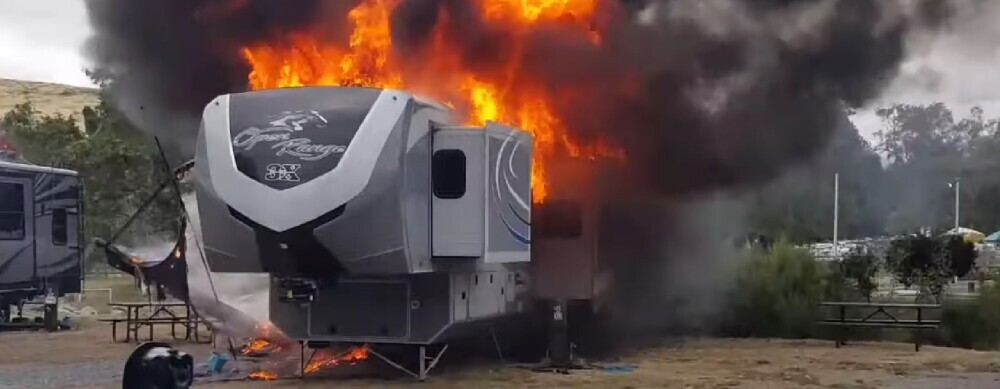
NOT WHAT AN RV OWNER WANTS TO SEE!
Living the RV life is full of adventure, freedom, and the joy of hitting the open road. But while the lifestyle offers a lot of fun, it’s also important to recognize that safety should always be a priority, especially when it comes to fire hazards. RVs are unique living spaces, and understanding fire safety within them is crucial to keeping you and your loved ones safe. In this blog post, we’ll walk through the basics of RV fire safety, preventative measures you can take, how to create an emergency plan, and what to do if a fire breaks out. Let’s dive in!
Our RV Fire Story!
Pam and I started RVing just after the turn of the century. So, we have been at this RV thing for what most would consider to be a long time. To date, over two hundred thousand miles traveled in many classes of RVs.
Early on, we rented RVs for vacations to test out our many choices before we decided to buy one. Our first RV was a big fifth wheel towed by a Freightliner truck.
When renting RVs, we were always told to leave the propane on while traveling because it kept the RV’s absorption refrigerator cold. That made sense to me, so we did.
A few years into our full time RV life, traveling with our fifth wheel, we stopped at a truck stop to fuel up. With the Freightliner, it was a dual-fill situation, so we would go through the truck lanes. I fueled up and decided to park in the truck lanes and take a break.
Pam got out to open up the fifth-wheel trailer and, upon looking in the door, yelled, FIRE! I was in the truck cab recording fuel data and heard her scream. I instinctively ran to the front of the RV where the propane cylinders were located and shot them off.
There was a fire brewing on the cooktop stove due to the propane being turned on and the flame adjustment knob set on full blast. How did that happen?
When moving from the fuel area to a parking spot, the RV rocked side to side due to the rutted roads at the truck stop. Heavy trucks leave ruts when asphalt softens in higher air temperatures.
So when the rocking occurred, plates fell out of a cabinet and landed on the cooktop control knobs: one turning on the auto piezo ignitor and the other turning the propane gas on full. Very shortly, that was heating up the cooktop cover, melting that, creating lots of smoke, and starting to work its way up a slideout wall.
When I cut the propane off, the fire stopped, and all that remained was a lot of toxic smoke. Fortunately, the Corian cover over the stove took most of the damage and prevented the fire from worsening.
Luckily, the RV did not sustain major damage. We were lucky. If I had not decided to take a break, the RV and truck would have been a total loss, kind of like the pictures in this post.
We learned a valuable lesson: Don’t travel with the propane on. We did not know that the RVIA makes this safety recommendation.
Understanding RV Fire Safety Basics
- Importance of fire safety in RVs
- Common causes of RV fires: electrical malfunctions, cooking accidents, and gas leaks
- Key differences between RV fire safety and traditional home fire safety
- Fire classification and appropriate fire extinguishers
Fire safety is a critical aspect of RV living that can’t be overstated. Unlike traditional homes, RVs are confined spaces filled with flammable materials and are often located in remote areas where emergency services might not be easily accessible. The risk of fire in an RV is always present due to various factors such as cooking, heating, and electrical systems. Understanding and implementing fire safety measures can mean the difference between a minor incident and a major catastrophe.

WOW, A FIRE OCCURING DURING TRAVEL!
Common Causes of RV Fires
RV fires can occur for several reasons, but the most common causes include electrical malfunctions, cooking accidents, and gas leaks.
– Electrical Malfunctions: Faulty wiring, overloaded circuits, or short circuits can easily ignite a fire in an RV. Many RVs have older electrical systems that may not be up to the demands of modern appliances, increasing the risk of an electrical fire.
– Cooking Accidents: Cooking is a leading cause of fires in traditional homes, and RVs are no different. The small kitchen spaces, combined with flammable materials and proximity to heat sources, make cooking a potential fire hazard.
– Gas Leaks: RVs often use propane or natural gas for cooking, heating, and powering appliances. A gas leak can quickly lead to a dangerous fire or explosion if not detected and addressed immediately.
Key Differences Between RV Fire Safety and Traditional Home Fire Safety
While the basic principles of fire safety apply universally, there are some key differences when it comes to RVs:
– Space Constraints: RVs are much smaller than traditional homes, which means a fire can spread more quickly and leave less time to react.
– Mobility: Unlike a stationary home, an RV is a vehicle that can be moved, which adds a layer of complexity to fire safety. For example, a fire could break out while the RV is in motion, requiring immediate and specific actions.
– Limited Exits: Most RVs should have two exits out of any room, making a quick evacuation more challenging. One is the doorway out of the room, but if blocked by fire, an emergency exit window should be available. Be sure those windows open: check regularly.
Fire Classification and Appropriate Fire Extinguishers
Understanding the types of fires that can occur in an RV is essential for choosing the right fire extinguisher:
– Class A: Fires involving ordinary combustible materials like wood, paper, and cloth.
– Class B: Fires involving flammable liquids such as gasoline, oil, and propane.
– Class C: Fires involving electrical equipment.
– Class D: Fires involving combustible metals, though these are rare in RV settings.
For RVs, a multi-purpose 1-A:10-B:C fire extinguisher is recommended, as it can handle most types of fires that are likely to occur.
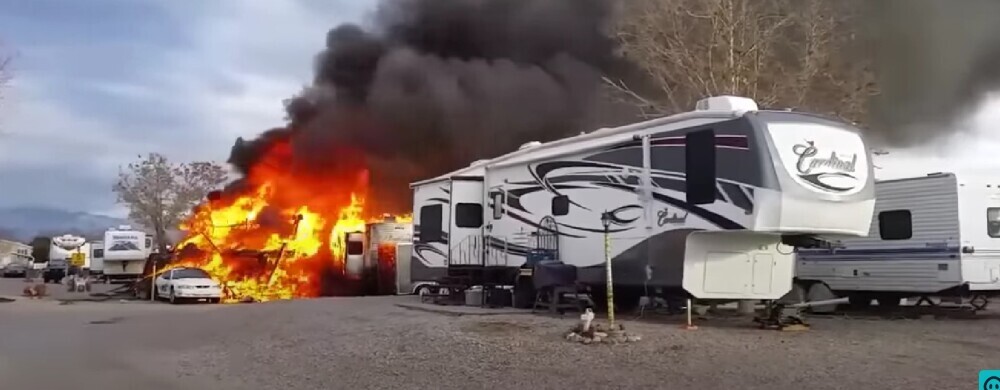
A TOTAL LOSS!
Preventative Measures to Avoid RV Fires
- Regular maintenance checks and their significance
- Proper handling and storage of flammable materials
- Importance of functioning smoke detectors and carbon monoxide detectors
- Guidelines for safe cooking practices in an RV
- Tips for safe usage of RV electrical and gas systems
Preventing a fire from starting in the first place is always better than dealing with one. Here are some key preventative measures every RVer should take:
Regular Maintenance Checks and Their Significance
Routine maintenance is vital for preventing fires. Regularly inspect your RV’s electrical systems, gas lines, and appliances to ensure they are in good working order. Pay particular attention to:
– Wiring and Outlets: Look for signs of wear, fraying, or loose connections.
Propane Systems: Check for leaks and make sure all connections are secure. It is best to have an RV propane system leak test done once a year. This requires the use of a manometer. A qualified RV technician can do this three-step test.
– Appliances: Ensure all appliances are functioning correctly and are not showing signs of malfunction.
Proper Handling and Storage of Flammable Materials
Flammable materials such as gasoline, propane, and cleaning supplies should be stored safely and securely. Keep them in well-ventilated areas away from heat sources and ensure containers are properly sealed.
Importance of Functioning Smoke Detectors and Carbon Monoxide Detectors
Smoke detectors and carbon monoxide (CO) detectors are your first line of defense in detecting a fire or gas leak early. Make sure they are installed correctly and test them monthly to ensure they are working. Replace batteries regularly, and never disable these devices.
For safety, these detectors must be replaced every five years from the date of manufacture stamped on the detector. If the manufacturer specifies something longer, go by that. For example, newer smoke detector models are now stamped with a statement saying to replace after ten years or may even list a date.
Guidelines for Safe Cooking Practices in an RV
Cooking in an RV requires extra caution due to the confined space and proximity to flammable materials. Here are some safety tips:
– Stay Present: Never leave cooking unattended. It only takes a moment for a fire to start.
– Ventilation: Ensure proper ventilation while cooking to avoid the buildup of smoke or gases.
– Clear Space: Keep flammable items like paper towels, clothes, and curtains away from the stove.
– Fire Extinguisher Nearby: Always have a fire extinguisher within reach when cooking. Most RV extinguishers installed by the manufacturer are located within twenty-four inches of the door.
Tips for Safe Usage of RV Electrical and Gas Systems
– Avoid Overloading Circuits: Be mindful of how many appliances you plug in at once. Overloading can lead to overheating and fires.
– Use Surge Protectors: Protect your RV’s electrical system from power surges, which can cause fires.
– Turn Off Gas When Not in Use: Always turn off the propane when you’re not using it, and never operate gas appliances while driving.
Creating an RV Fire Emergency Plan
- Importance of having an emergency plan
- Steps to create a comprehensive fire evacuation plan
- How to conduct regular fire drills
- Training family members on emergency procedures
- Assembling an emergency kit specific for fire emergencies
Even with the best prevention, it’s essential to be prepared for the possibility of a fire. A well-thought-out emergency plan can save lives.
Importance of Having an Emergency Plan
An emergency plan ensures that everyone in the RV knows what to do in the event of a fire, minimizing panic and confusion. It’s a crucial step in ensuring your safety and the safety of your loved ones.
Steps to Create a Comprehensive Fire Evacuation Plan
– Identify Exits: Know all possible exits in your RV, including windows that can serve as emergency exits.
– Escape Routes: Plan and practice escape routes from different areas of the RV. Make sure they are clear of obstructions.
– Meeting Point: Establish a safe meeting point outside the RV where everyone will gather after evacuating.
How to Conduct Regular Fire Drills
Practice makes perfect, and this is especially true for emergency situations. Conduct regular fire drills to ensure everyone knows what to do:
– Simulate Different Scenarios: Practice evacuating from different areas of the RV and under various conditions, such as during the day and at night.
– Time Your Drills: See how quickly everyone can evacuate and aim to improve the time with each drill.
– Review and Adjust: After each drill, discuss what went well and what could be improved, and adjust your plan accordingly.
Training Family Members on Emergency Procedures
-Everyone in the RV, including children, should know how to respond to a fire emergency. Teach family members how to:
– Use a Fire Extinguisher: Ensure everyone knows how to operate a fire extinguisher correctly.
– Call for Help: Make sure everyone knows how to contact emergency services.
– Follow the Plan: Reinforce the importance of following the emergency plan during a real fire.
Assembling an Emergency Kit Specific for Fire Emergencies
Prepare an emergency kit that is easily accessible and contains:
– Fire Extinguishers: Make sure you have at least one, but preferably more.
– First Aid Supplies: Include burn ointments, bandages, and other first aid items.
– Flashlights and Batteries: In case of power loss during a fire.
– Emergency Contacts: A list of emergency contacts, including local fire services.
What to Do in Case of an RV Fire
- Immediate actions to take if a fire starts
- How to use an RV fire extinguisher effectively
- Evacuation protocols and safe exits
- Emergency contacts and communication during a fire
- Post-fire actions: assessing damage and steps to recovery
If a fire does occur, it’s essential to act quickly and efficiently to ensure everyone’s safety. Remember, a fire inside an RV will spread very quickly due to the materials it is constructed of.
Immediate Actions to Take if a Fire Starts
– Stay Calm: Try to remain calm so you can think clearly and act effectively.
– Alert Everyone: Make sure everyone in the RV is aware of the fire immediately.
– Assess the Situation: Determine if the fire is small enough to be extinguished with your fire extinguisher or if it requires immediate evacuation. You can also use a fire blanket for kitchen fires that may start! They have the benefit of quickly extinguishing the fire and not creating the mess a fire extinguisher does.
How to Use an RV Fire Extinguisher Effectively
Using a fire extinguisher might seem straightforward, but in the heat of the moment, it’s easy to forget the basics:
– Pull the Pin: Release the locking mechanism.
– Aim Low: Point the extinguisher at the base of the fire, not the flames.
– Squeeze the Handle: Discharge the extinguisher in a slow, controlled manner.
– Sweep Side to Side: Move the nozzle from side to side until the fire is out.
Evacuation Protocols and Safe Exits
If the fire is too large to handle:
– Evacuate Immediately: Don’t waste time trying to gather belongings; get out as quickly as possible.
– Use the Safest Exit: Use the exit furthest from the fire if possible.
– Stay Low: If there’s smoke, stay low to the ground where the air is clearer.
Emergency Contacts and Communication During a Fire
Once you’re safely out of the RV:
– Call 911: Contact emergency services immediately.
– Use Your Emergency Plan: Follow your plan, including meeting at the designated point.
– Notify Campground Staff: If you’re at a campground, inform the staff, as they may be able to assist or need to alert other campers.
-Post-Fire Actions: Assessing Damage and Steps to Recovery
After the fire has been dealt with:
– Assess Damage: Once it’s safe, assess the damage to your RV. Take photos for insurance purposes.
– Contact Insurance: Notify your insurance company too.
Keep safe while enjoying RV travel! Hopefully, these tips will help with RV fire safety within the RV life!
To learn more about us, click here!
Please feel free to leave a comment or ask a question before you go.

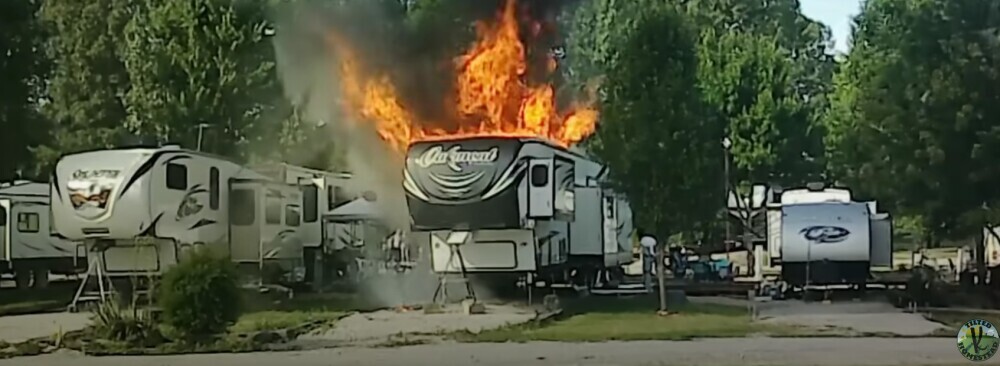
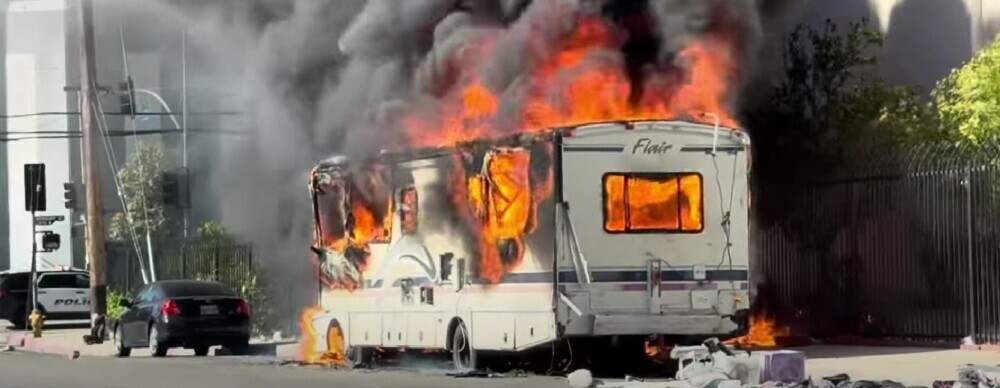
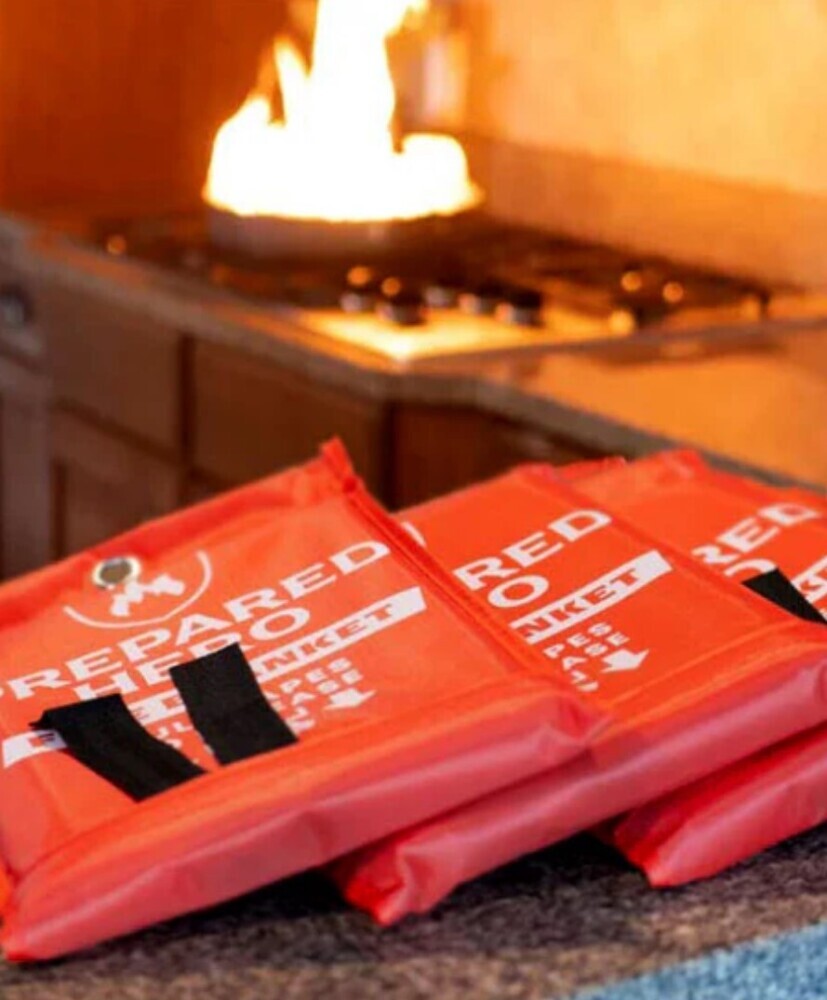

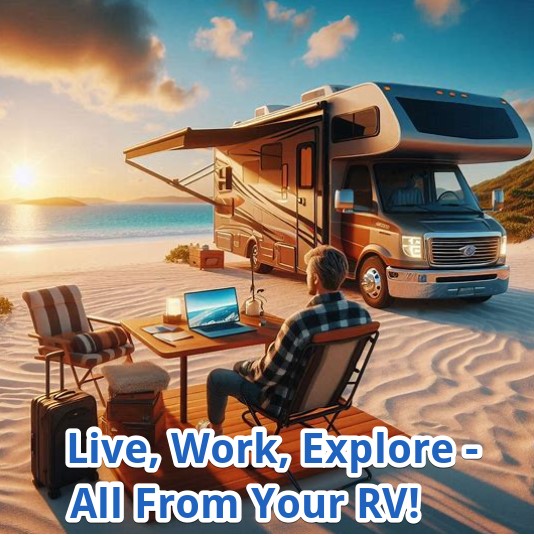
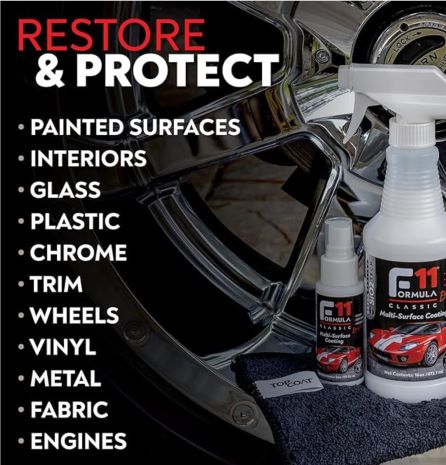
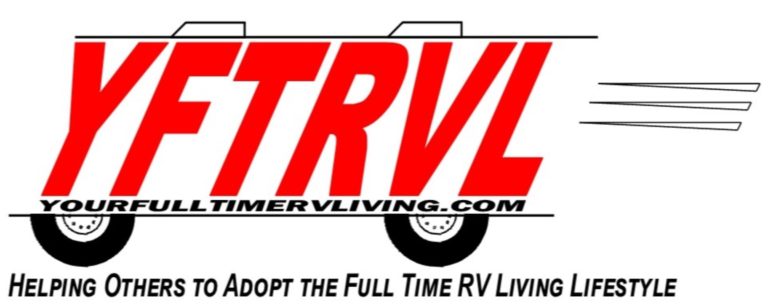



Recent Comments